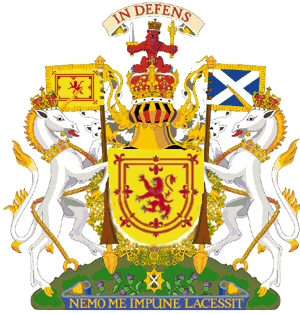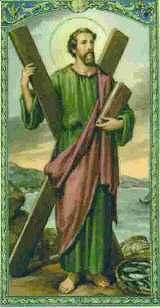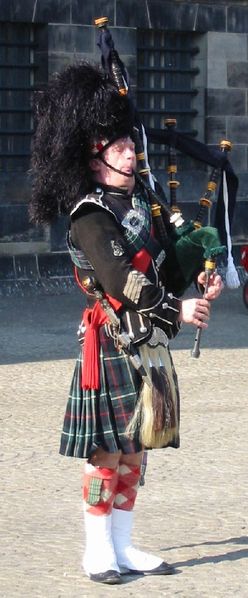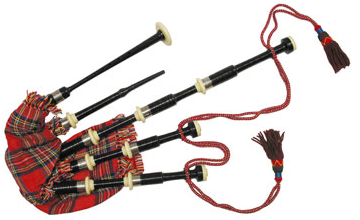
Legend says that
in 832 AD, an army of Scots was facing a Northumbrian army. The Scottish king
prayed to St Andrew for help, and saw the saltire of
St Andrew (the saint had been martyred on a diagonal cross) in the heavens
against a clear blue sky. On seeing the cross in the sky, he swore that if the
Scots beat the English in the battle that was about to be joined, then St
Andrew would forever be the patron saint of
 The
Royal Standard of Scotland is the Royal
Flag of Scotland, and strictly speaking should only be used by the king or queen
of the
The
Royal Standard of Scotland is the Royal
Flag of Scotland, and strictly speaking should only be used by the king or queen
of the
Written
by
O Flower of Scotland when
will we see your like again,
That fought and died for your wee bit Hill and Glen
And stood against him proud Edward's Army,
And sent him homeward, Tae think again.
The Hills are bare now and
autumn leaves lie thick and still
O'er land that is lost now which those so dearly held
That stood against him proud Edward's Army
And sent him homeward, Tae think again.
Those days are past now and
in the past they must remain
But we can still rise now and be the nation again
That stood against him proud Edward's Army
And sent him homeward, Tae think again.
O Flower of Scotland when
will we see your like again,
That fought and died for your wee bit Hill and Glen
And stood against him proud Edward's Army,
And sent him homeward, Tae think again.

They are on display in
The Crown
It is not known exactly how old this
crown is, it probably dates from Robert Bruce’s reign (1314). The crown was remodelled for James V in 1540.
It is made from Scottish gold from the Crawford Moor mine, actively worked at
the time. The craftsmanship is French.
The Sceptre
A gift from the Pope to James IV in
1494. It was refashioned for James V, who seemed to have liked jewellery, because
he added his initials to the sceptre. The globe of the sceptre is a cut and
polished rock crystal, with a Scottish pearl on top.
The Sword of State
Another gift from another pope to
James IV in 1507. A fine example of craftsmanship, it came complete with a sword
belt and a consecrated hat. The blade of the sword is a metre long.
Following the
Treaty of Union in 1707, the ancient crown jewels of
 The
Royal Coat of Arms of Scotland was the official coat of arms of the
monarchs of Scotland, and were used as the official coat of arms of the Kingdom
of Scotland until the Union of the Crowns in 1603. Afterwards, the arms became
an integral part of the Royal Coat of Arms of the United Kingdom.
The
Royal Coat of Arms of Scotland was the official coat of arms of the
monarchs of Scotland, and were used as the official coat of arms of the Kingdom
of Scotland until the Union of the Crowns in 1603. Afterwards, the arms became
an integral part of the Royal Coat of Arms of the United Kingdom.
The shield depicts a red lion rampant on a yellow field, surrounded by and double tressure fleury-counter-fleury.
The crest is a red lion sitting on a crown, holding a sword and a sceptre.
The supporters are two crowned unicorns, the dexter supporter holds a banner of the arms; the sinister supporter holds the national flag of Scotland.
The coat features both the motto Nemo me impune lacessit (No-one wounds (touches) me with impunity) and the Order of the Thistle around the shield.
Today The Royal Coat of Arms of Scotland are not used in any official capacity on their own, although they do feature in the second quarter of the Royal Coat of Arms of the United Kingdom;
|
Although Andrew
and his brother Peter were two of the original apostles, very little is known
about Andrew. He was a fisherman from
Some 300 years
after his death, the Emperor Constantine was going to move the saint’s bones,
and legend has it that a monk was warned of this in a dream by an angel, who
told him to remove the saints bones to the "ends
of the Earth" to keep them safe.
A chapel was
built to house them, and by 1160 a cathedral. |
 Scotland
Scotland
A legend says that in the late 8th century, during a joint battle with the English, King Oengus mac Fergus of the Picts and King Eochaid IV of Dalriada, saw a cloud shaped like a saltire, and declared Andrew was watching over them, and if they won by his grace, then he would be their patron saint.
Each year on January
25, the great man's presumed birthday, Scots everywhere take time out to honour
the national icon,
Sequence of Events at a Burns Supper
|
Auld Lang Syne Should auld acquaintance be forgot And never brought to mind? Should auld acquaintance be forgot, And auld lang syne?
Chorus For
auld lang syne, my jo,
And surely
ye'll be your pint-stoup,
We twa hae
run about the braes,
We twa hae
paidl'd in the burn,
And
there's a hand, my trusty fiere! |
1. Chairman's
speech to welcome company, normally a few short sentences.
2. Then the Grace
(prayer) follows. Traditionally, Burns's Selkirk Grace is used:
Some hae meat and canna eat,
And some wad eat that want it;
But we hae
meat and we can eat,
And sae the Lord be thankit.
3. First
course of the dinner, Scotch Broth
or Cock a Leekie.
4. Chairman
rises and invites company to rise to welcome
haggis
being piped in.
5. Once
haggis is placed on table, the chef and the piper have a drink then leave.
6. Address to
haggis now given and company stand to toast haggis, then it is cut open. Haggis
is eaten with "tatties and neeps"
7. Company
sit and meal continues. The rest of the meal can really be whatever one
chooses. Traditional puddings would be
Tipsy Laird or
Atholl Brose, with oatcakes and
cheese before coffee
8. Coffee is
served and the Chairman announces an interval (usually 10 to 15 minutes), when the
company can relax before speeches etc.
9. Toasts
and speeches follow.
10. Entertainment
begins (songs and poems etc), after which the Chairman calls on company to sing
"Auld Lang Syne".
 There are
estimated to be around 85,000 people
who can speak the Scottish Gaelic
language. It is mainly spoken in the North
of Scotland and on the Western Isles. Scottish Gaelic has a certain similarity to Irish Gaelic, but is very different
from the Welsh Gaelic and its family (Cornish and Breton).
There are
estimated to be around 85,000 people
who can speak the Scottish Gaelic
language. It is mainly spoken in the North
of Scotland and on the Western Isles. Scottish Gaelic has a certain similarity to Irish Gaelic, but is very different
from the Welsh Gaelic and its family (Cornish and Breton).
The Celts, who
spoke Gaelic languages, dominated
The Celts did not
have a
In 843 a great
Gaelic leader, Kenneth MacAlpin was able to unite the
Picts and the Gaels for the first time. His territory
was called Alba (still the Gaelic name for
There was then a period of Viking raids and invasions, but after some two
hundred years Somerled, one of the great Celtic
leaders, drove the Vikings out. He became the Lord of the Isles, controlling
both the Western Isles and parts on the mainland in northern
In 1745, with an
army of only 5000, Bonnie Prince Charlie took
With this defeat
came repression of both the Gaelic
language and all things Gaelic. There was a methodical eradication of the
Gaelic culture by the British government. Everything from tartans to bagpipes
was banned, and the clan culture was removed by new landowners.
It took until 1886 for
crofters to be given security of tenure on their land, but Gaelic was still
discouraged. It has only really been since the 1980's that there has been a revival in Gaelic. There are Gaelic
playgroups and the language is taught in some schools. Many organisations like
banks and local authorities are using Gaelic names.

…is known as
As the story
goes, a long time ago when Scotland was being ravaged by Viking invaders, prior
to the Battle of Largs in 1263, a group of Scottish
fighting men were resting overnight in a field. Unknown to them, a raiding
party was preparing to attack this group of Scots, under cover of darkness. As
the attacking Vikings approached the encamped Scots, they stood on a patch of
Thistles with their bare feet and let out cries of pain as the thorns dug deep
into their feet. The Scots, having been awakened by the noise were able to
fight off the attackers and drive them back across the
|
Formal Highland regalia: kilt and Prince Charlie jacket with Black tie.
|
A tartan is a specific woven pattern that often signifies a particular Scottish clan in the modern era. The blocks of colour repeat vertically and horizontally in a distinctive pattern of squares and lines. Kilts almost always have tartans.
Parti-coloured cloth was used by the Celts from the earliest time, but the variety of colours in the breacan was greater or less, according to the rank of the wearer. That of the ancient kings had seven colours, that of the druids six, and that of the nobles four.
For many centuries, the patterns were loosely associated with the weavers of a particular area, though it was common for highlanders to wear a number of different tartans at the same time. In the 17th c. the tartans seemed to be used to distinguish the inhabitants of different districts and not the inhabitants of different families as at present. The inhabitants of various islands were not all dressed alike, and colours of the various tartans varied from isle to isle. The naming and registration of official clan tartans began only in 1815.

 Many outsiders associate Scottish folk music almost entirely with bagpipes, which
has indeed long played an important part of Scottish music. It is, however, not
unique or indigenous to Scotland, having been imported around the 15th
century and still being in use across Europe (
Many outsiders associate Scottish folk music almost entirely with bagpipes, which
has indeed long played an important part of Scottish music. It is, however, not
unique or indigenous to Scotland, having been imported around the 15th
century and still being in use across Europe (![]() kecskeduda in Hungary) and farther abroad. The
pìob mór, or Great Highland
Bagpipe, is the most distinctively Scottish form of the instrument; it was
created for clan pipers to be used for various, often military or marching,
purposes.
kecskeduda in Hungary) and farther abroad. The
pìob mór, or Great Highland
Bagpipe, is the most distinctively Scottish form of the instrument; it was
created for clan pipers to be used for various, often military or marching,
purposes.
Scottish music comes in many forms. First of all there are the summer shows you will find throughout Scotland, mostly aimed at tourists. These shows host a predominance of tartan, bagpipes, highland dancing, comedy and songs of hills and heather - essentially the image many tourists have of Scotland.
Increasing in popularity is the 'Ceilidh Dance' (pronounced kay-lay) which is an informal evening of Scottish county dancing, singing and, of course, drinking good whisky where formality goes out the window. A dance caller shouts out instructions to experienced dancers and beginners alike. The main objective is enjoyment, getting the dance steps wrong is almost irrelevant.
Folk festivals comprise of a mixture of concerts, ceilidhs and workshops where young and learner musicians can seek tuition from some of Scotland's top folk artists.
The music of Scotland has kept many of its traditional aspects; indeed, it has itself influenced many forms of music, though Scottish traditional music has been influenced by both Irish and English traditional music.
There are three principle categories of Scottish music: ballads, dance music and military music.
learn more:
Almost everything about Scotland and the Scots
sources:
National Statistics, UK 2002, The Official Yearbook of Great Britain and Northern Ireland
Wikipedia: Tartan, Coat of Arms, Music
credits:
The text was composed by using private works of the authors and relevant materials of...
1. The Official Yearbook of Great Britain and Northern Ireland © Crown Copyright 2001.
2. 'Auld Lang Syne' audio clip © Maybole Community Council, Ayshire, Scotland 1999-2006
 A
kilt is a skirt-like traditional garment of Scottish, possibly Celtic
(Yes, men in Wales also wear kilts especially on St David's day or during
cultural festivals) culture that exists in various modern forms and forms
inspired by the historical garment.
A
kilt is a skirt-like traditional garment of Scottish, possibly Celtic
(Yes, men in Wales also wear kilts especially on St David's day or during
cultural festivals) culture that exists in various modern forms and forms
inspired by the historical garment.